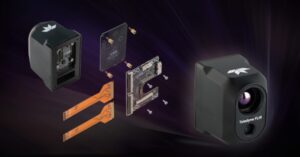
by DRONELIFE Staff Writer Ian M. Crosby
Today, Teledyne FLIR released development kits for easy integration of its FLIR Hadron 640R thermal and visible dual camera module.
Read more:
The kits include hardware and reference software drivers, which are compatible with development boards that support the NVIDIA Jetson Nano, the Qualcomm RB5, and the Qualcomm Snapdragon 865.
The Hadron 640R’s compact 640×512 resolution radiometric Boson® thermal camera module grants visibility within total darkness, smoke, and most fog. The module also features a 64MP visible electro-optical (EO) camera for high-definition visible imagery.
The development kits allow integrators to begin imaging and controlling the cameras in only a matter of hours. This rapid and easy integration lowers development time and costs significantly, cementing the solution as the perfect dual sensor payload for integration into unmanned aircraft systems (UAS), unmanned ground vehicles (UGV), robotic platforms, and AI-ready applications necessitating efficient battery run-time and battery life.
“The powerful Hadron 640R development kits provide integrators industry-leading thermal and visible camera operation using both Linux and Android application development,” said Michael Walters, vice president, product management, Teledyne FLIR. “Combined with the size, weight, and power optimized Hadron 640R and the Teledyne FLIR technical services team to support integration, these development kits further maximize efficiency for developers at every stage.”
The Hadron 640R features low, steady-state power consumption at 1.8W and an IP-54 rating, resulting in increased battery operation time all within a compact, lightweight 56-gram camera module. The plug-and-play development solution enables same-day operation, and includes interface boards, cabling hardware, and reference software drivers.
Read more:
- From the Floor of Xponential 2022: Teledyne FLIR Hadron™ 640R; More Power, More Resolution in a Small Form Factor
- FLIR’s New Sensor Module Hadron™ a Drone Industry First
- Florida Drone Supplys 3 Month Review of Teledyne FLIRs SIRAS: the Pros, the Cons, and the Upshot
- Teledyne FLIRs New Drone: SIRAS™ Fills a Gap in the Industry
- Mapping with Thermal Drones: Teledyne FLIR Talks Best Practices
Ian attended Dominican University of California, where he received a BA in English in 2019. With a lifelong passion for writing and storytelling and a keen interest in technology, he is now contributing to DroneLife as a staff writer.
Miriam McNabb is the Editor-in-Chief of DRONELIFE and CEO of JobForDrones, a professional drone services marketplace, and a fascinated observer of the emerging drone industry and the regulatory environment for drones. Miriam has penned over 3,000 articles focused on the commercial drone space and is an international speaker and recognized figure in the industry. Miriam has a degree from the University of Chicago and over 20 years of experience in high tech sales and marketing for new technologies.
For drone industry consulting or writing, Email Miriam.
TWITTER:@spaldingbarker
Subscribe to DroneLife here.